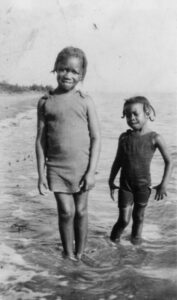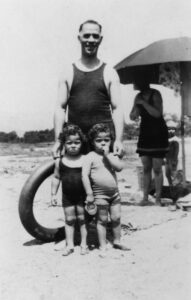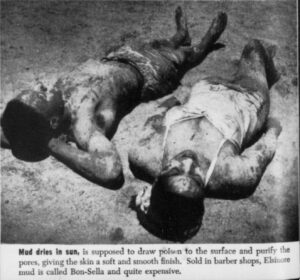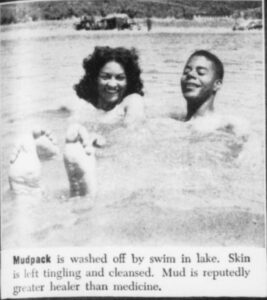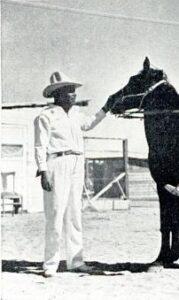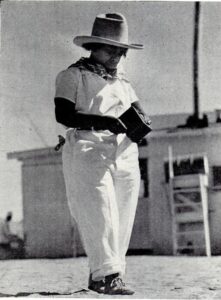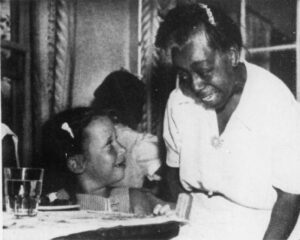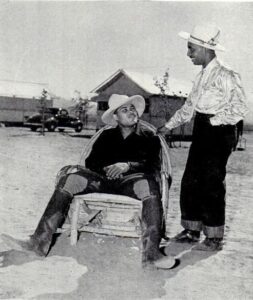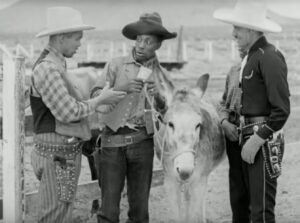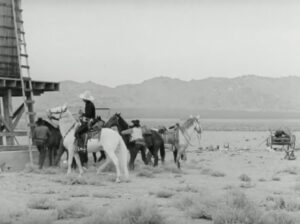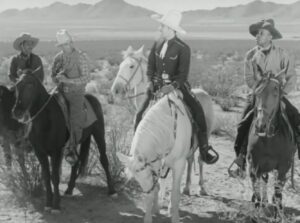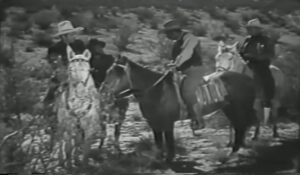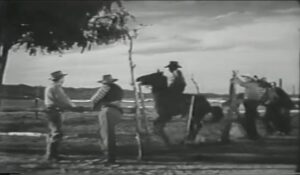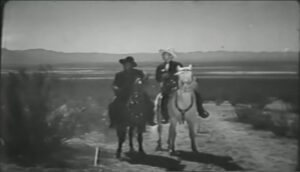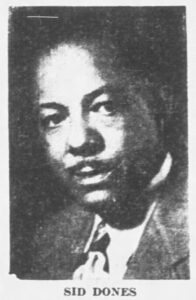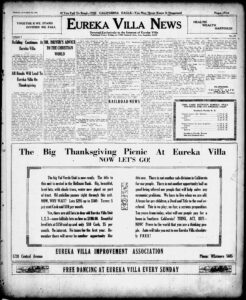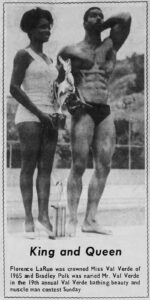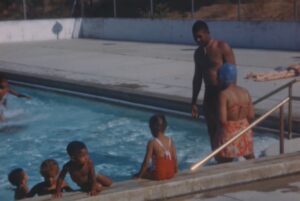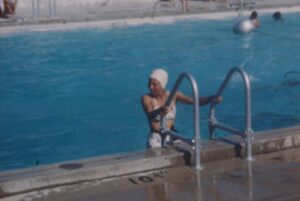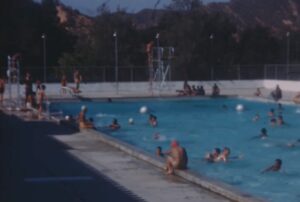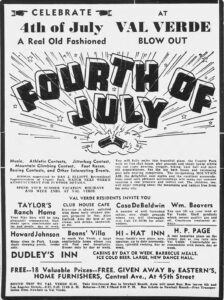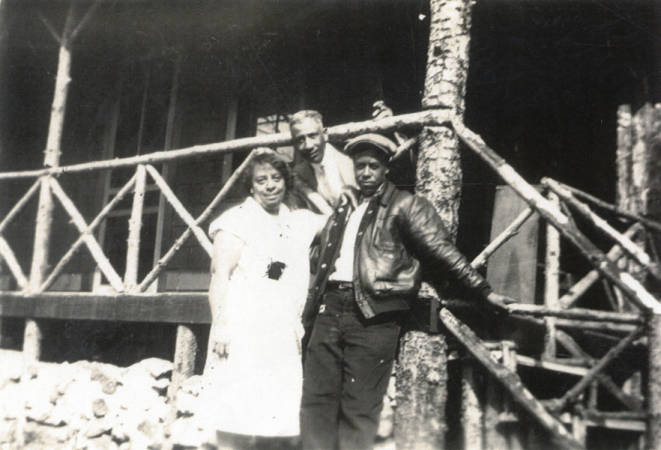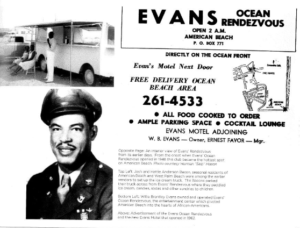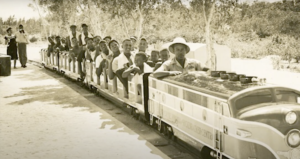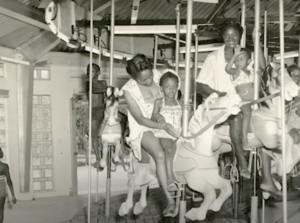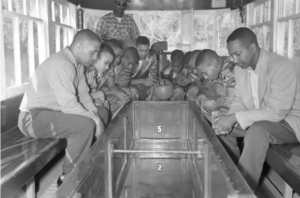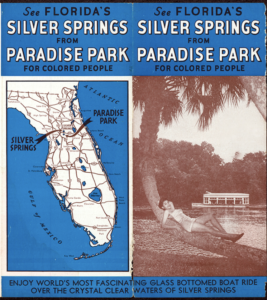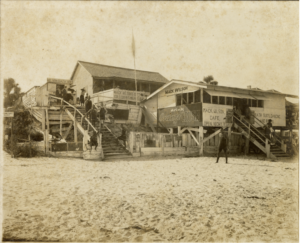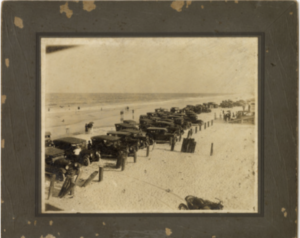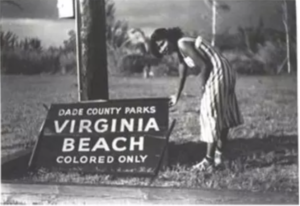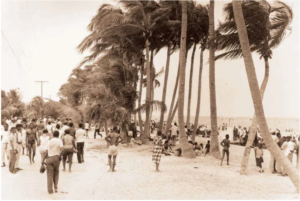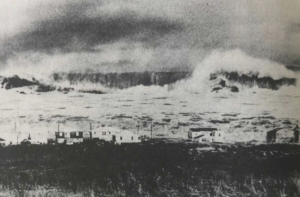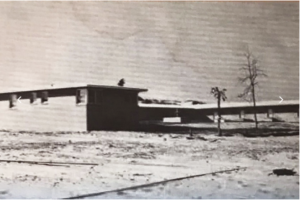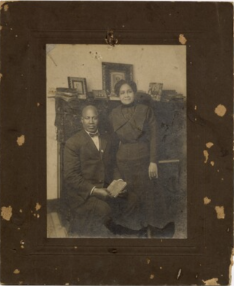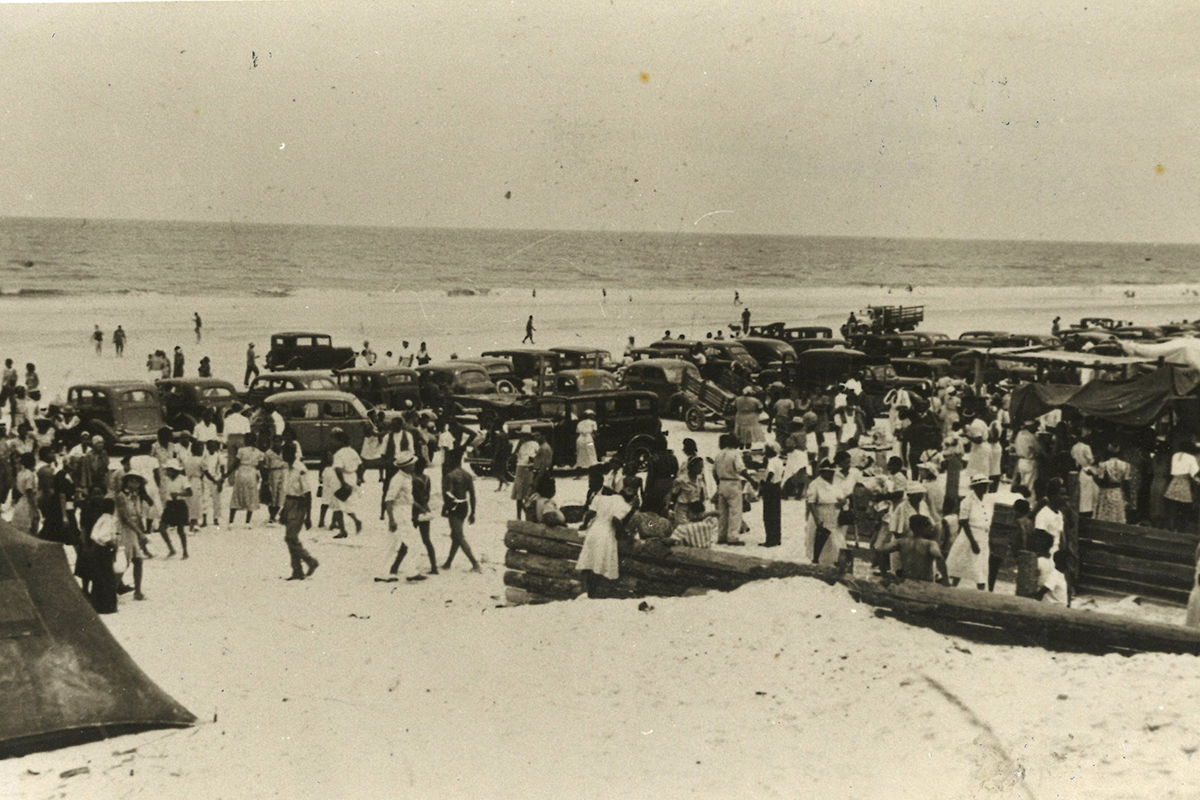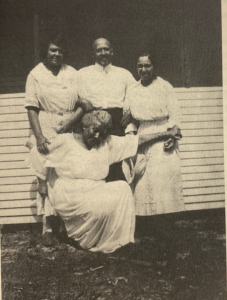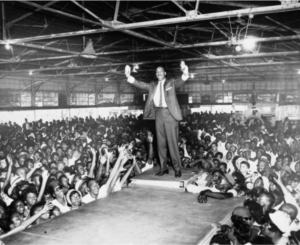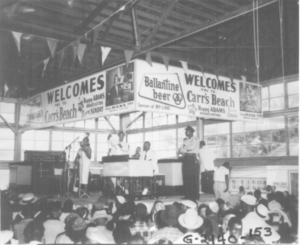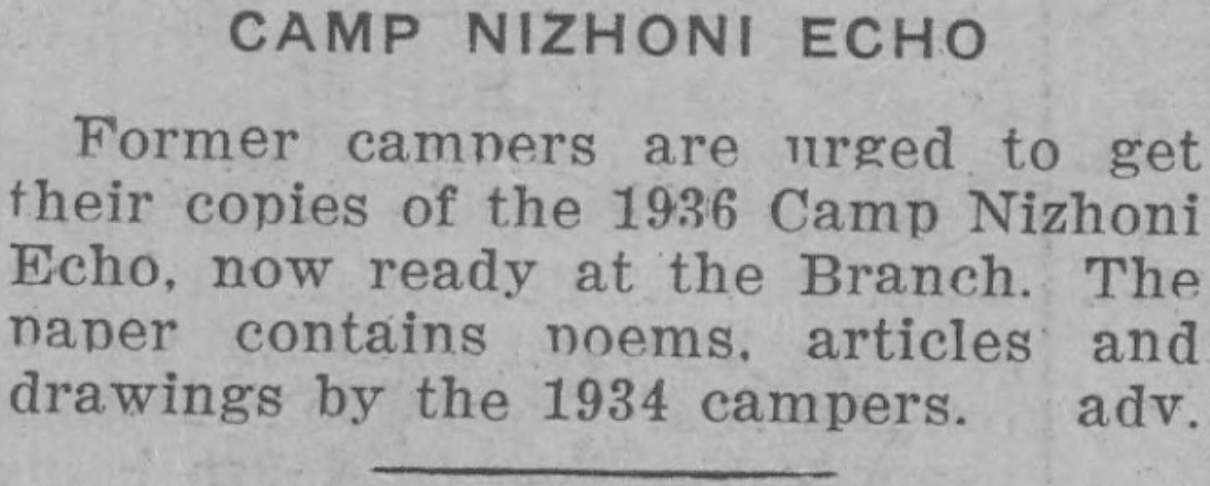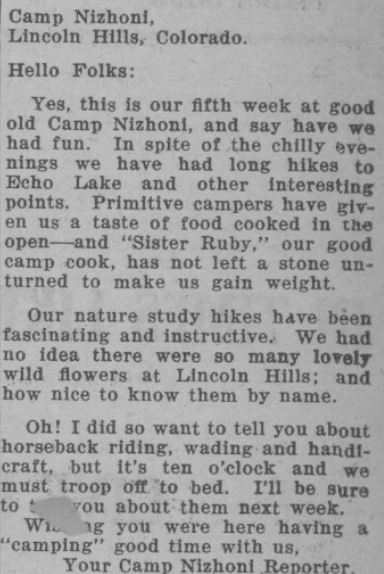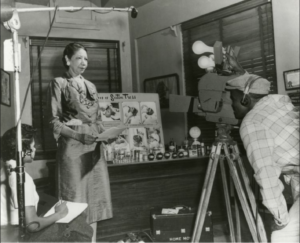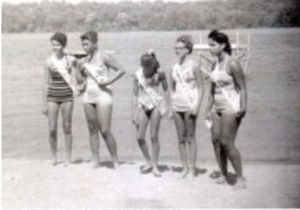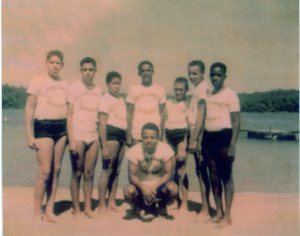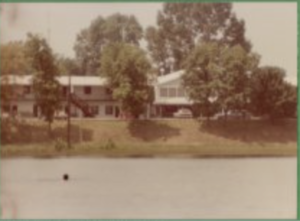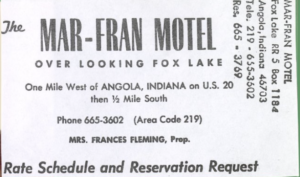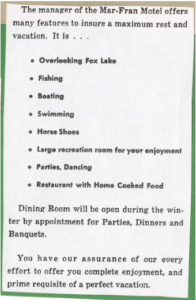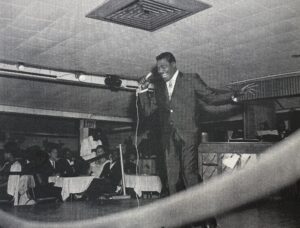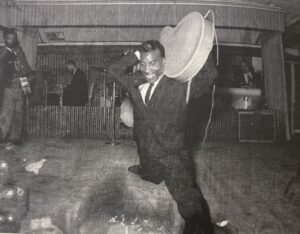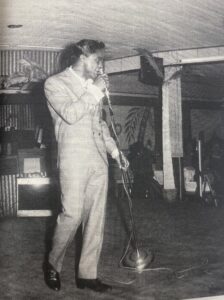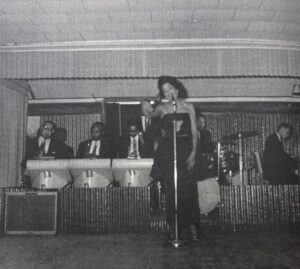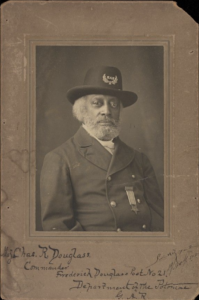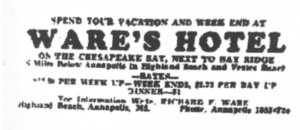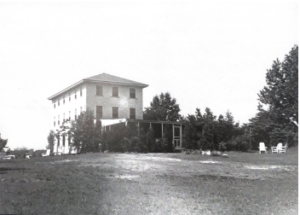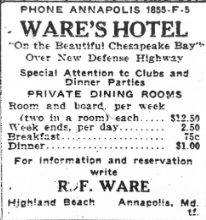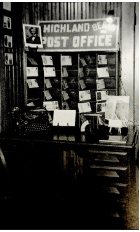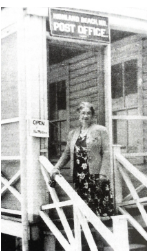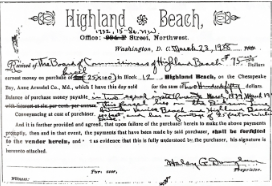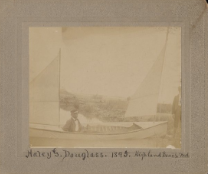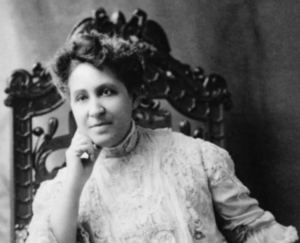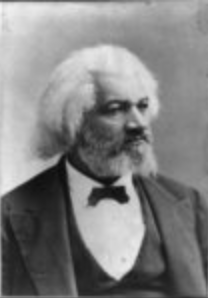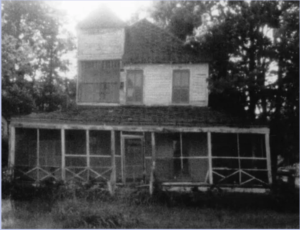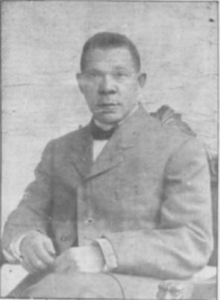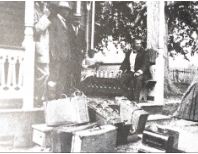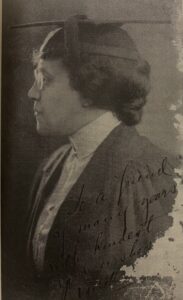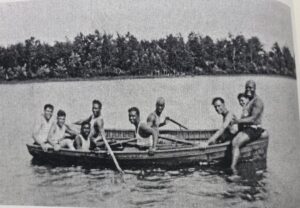
California Resorts
Southern California was home to many attractions for Black folks looking for rest and leisure. Amidst California’s diverse natural landscapes, Black-owned and operated establishments such as Lake Elsinore, Murray’s Dude Ranch, and Val Verde offered gorgeous lakes and valleys, serene desert terrain, and more.
Lake Elsinore, situated in Riverside County, was a popular destination for rest and recreation and was known for its natural attractions. The lake town was initially established in 1887, although it was not a site for African American leisure until the 1920s. Early on in its history, William Charles Burgess and Hannah Burgess moved to Elsinore to work as domestic service employees. The two were soon able to purchase property to build a small lodge called Rieves Inn. In doing so, the Burgesses laid the groundwork for the “main thoroughfare of the African American vacation and year-round community.”2 By the mid-1920s, Black Angelenos began purchasing vacation homes in the area, and Lake Shore Beach was established on the north shore of Lake Elsinore. The Rieves Inn was purchased and renovated in 1938 by a mother and daughter, Mrs. Mary E. Baker and Mrs. Eula Reeves, who renamed the establishment Elsinore Inn. With these renovations, the Inn offered tourists 15 rooms and 4 cabins to rent, contributing to the lake town’s reputation of unrivaled hospitality.
Lake Elsinore was favored throughout the hot summer months, beginning with the gala summer opening, which attracted crowds of Black folks “national in scope.”3 Its 7-mile lake was the site of “excellent swimming, fishing, and boating,” and patrons were never a far bike ride away from a dance pavilion, a tasty chicken dinner, or a game of croquet.3 For those who desired a more serene experience, Elsinore was also home to natural hot springs, sulfur water, and mud baths. Many folks claimed that these mellow features had certain healing powers. Both the lake and the hot springs rejuvenated Elsinore’s visitors and connected them back to nature. To some, Lake Elsinore’s beauty was comparable to Palm Springs, California.
Travel a few hours northeast of Los Angeles, and you would arrive at Murray’s Overall Wearing Dude Ranch. Operating out of Victorville in the Mojave Desert, Murray’s Dude Ranch was the only Black-owned US ranch run by Nolie and Lela Murray. The Murrays purchased 40 acres of desert land in 1926 with the intention of farming chickens as well as housing and nursing underprivileged children. Lela, a registered nurse, “[had] made a specialty of caring for children suffering from respiratory ailments.”1 The Murrays were running a small operation until a few moments in the spotlight brought them booming business. First was a visit from heavyweight champion Joe Louis, featured in Life magazine in 1937. During his stay, the ranch was overcrowded with 50 guests, inspiring the Murrays to convert their establishment from farmland to a guest ranch. Next was the ranch’s selection as a movie location for the 1939 films The Bronze Buckaroo and Harlem Rides the Range, marking “the first time in the history of the Negro movie industry [that] an all-colored talking picture was filmed on a colored location.”1 What sealed the deal for the Murray’s success was an article about the ranch featured in People’s World magazine and reprinted in Negro Digest in 1945. Exposure by these two papers sent eager crowds on their way to the Californian desert.
In its prime, Murray’s Dude Ranch hosted about 100 people weekly from May through September. Patrons of the ranch stayed in red-roofed cabins and cottages made of white stucco. Guests could visit the stables, take an hour-long horseback ride through the desert terrain, cool off in the swimming pool, and even hunt for jackrabbits. In addition, the ranch offered tennis courts, a baseball diamond, golf, croquet, and horseshoe pitching. The ranch catered to everyone: children, families, famous visitors like Lena Horne, Kate Smith, Hedda Hopper, and Freddie Bartholomew, and even soldiers during World War II. It is hard to pinpoint the demographic Murray’s Dude Ranch served; An Ebony magazine feature in 1947 wrote, “Each week sees a startling difference in newcomers. A party of whites from Iowa stops for two days…The Negro congregation from a local Baptist church comes… A quiet Spanish couple arrives… A Negro girl student from Seattle, Washington, is here…”1 Murray’s Overall Wearing Dude Ranch hosted a range of unique patrons, all in pursuit of the three R’s of the ranch: rest, recuperation, and recreation.

Val Verde, Spanish for ‘Green Valley,’ was located 42 miles northwest of Los Angeles in the San Martinez Chiquito Canyon. Once fully developed, this vacation resort measured almost 800 acres in size. Val Verde’s development as an African American site of leisure and recreation began in collaboration between a wealthy white woman, Mrs. Laura C. Janes, and an African American real estate broker, Sidney P. Dones. In the 1910s, Janes opened her ranch land to Black folks, motivated by her “dismay at the discrimination they confronted.”2 Dones “timely and foresighted business deal with Janes” set in motion the transformation of the land into a mecca of opportunity and leisure for Black Angelenos as well as folks across the country, with lot sales and community building taking off around 1925.2 The initial investors called their proposed community Eureka Villa, and for a time, the name stuck until it was eventually changed back to Val Verde in 1939.
It was not uncommon for folks to visit Val Verde during the summer months and decide to make it their permanent home. The resort had the perfect mix of scenic leisure and lively recreation. Val Verde offered baseball, golf, tennis, hiking, horseback riding, fishing, dances, beauty and physique contests, weightlifting competitions, parades, art and hobby shows, and theater productions. However, one of the most highly anticipated features of Val Verde was the Olympic-sized pool, completed in July 1940, where many young kids learned how to swim. Val Verde was also host to many holiday events for Easter, Memorial Day, the 4th of July, Labor Day, Thanksgiving, and Christmas, pulling in crowds as large as 18,000 in a single day. The resort served as a large-scale treasured space for relaxation, where “…people [could] come from all parts and have the feeling that, above all, the world can offer nothing better.”4
1“California Dude Ranch.” Ebony, February 1947. https://archive.org/details/sim_ebony_1947-02_2_4/mode/2up.
2Jefferson, Alison Rose. Living the California Dream: African American Leisure Sites during the Jim Crow Era. University of Nebraska Press, 2020. https://doi.org/10.2307/j.ctvsn3p0k.
3“Lake Elsinore Opening Offers New Features.” The California Eagle. May 23, 1940. https://www.newspapers.com/image/692879312/.
4“Spend Your Week-Ends- In Val Verde!” The California Eagle. February 1, 1940. https://www.newspapers.com/image/692881298/.
Bautista, Anthony. “Victor Valley Museum Spotlights World’s First Black-Owned Dude Ranch.” NBC Los Angeles, February 28, 2023. https://www.nbclosangeles.com/news/local/victor-valley-museum-worlds-first-black-owned-dude-ranch/3098786/.
“Elsinore Inn in Grand Opening.” The California Eagle. May 5, 1938. https://www.newspapers.com/image/693166019/.
Granda, Carlos. “LA County’s Val Verde Community, Once Known as ‘the Black Palm Springs,’ Holds Fond Memories.” ABC7 Los Angeles, February 22, 2022. https://abc7.com/val-verde-black-palm-springs-castaic/11587364/.
“Jackie Wilson at Murray’s Dude Ranch.” The California Eagle. November 27, 1941. https://www.newspapers.com/image/692925743/.
Jefferson, Alison Rose. Living the California Dream: African American Leisure Sites during the Jim Crow Era. University of Nebraska Press, 2020. https://doi.org/10.2307/j.ctvsn3p0k.
Ms. Val Verde, Chiquito Canyon, Del Valle, and San Martinez Roads in the Santa Clarita Valley, Val Verde, Los Angeles County, CA. Los Angeles, 2000. https://www.loc.gov/item/ca4482/.
“Lake Elsinore Opening Offers New Features.” The California Eagle. May 23, 1940. https://www.newspapers.com/image/692879312/.
“Negro Dude Ranch Opens in California.” Life, November 15, 1937. https://books.google.com/books?id=kj8EAAAAMBAJ&printsec=frontcover&source=gbs_ge_summary_r&cad=0#v=onepage&q&f=false.
Ott, Chris. “Eureka Villa/Val Verde, California.” Black Past, January 23, 2007. https://www.blackpast.org/african-american-history/eureka-villa-val-verde/.
Swann, Jennifer. “When Val Verde Was Eureka Villa.” Curbed LA, September 27, 2017. https://la.curbed.com/2017/9/27/16351910/val-verde-landfill-eureka-villa-history-california.
William-Ross, Lindsay. “LAistory: Val Verde, The ‘Black Palm Springs.’” LAist, May 2, 2008. https://laist.com/news/laistory-val-ve.
“Your Eagle Real Estate Section.” The California Eagle. May 16, 1946. https://www.newspapers.com/image/692937130/.
List of Images
- Cover Photo: Black and white photo of Lake Elsinore from above. Los Angeles Public Library Digital Collections, https://tessa2.lapl.org/digital/collection/photos/id/115929/rec/21.
- Map thumbnail – Advertisement for Val Verde that reads “A Year Round Playground For All” from the California Eagle. https://www.newspapers.com/image/693653282/.
- Map Thumbnail – Two women swimming in the pool at Murray’s Dude Ranch. https://books.google.com/books?id=kj8EAAAAMBAJ&printsec=frontcover&source=gbs_ge_summary_r&cad=0#v=onepage&q&f=false.
- Map Thumbnail – Cars parked along the edge of the lake with a caption that reads “Boat Races Lake Elsinore 1937”. https://lamag.com/featured/african-american-beaches-leisure-history.
- Map Thumbnail – Advertisement for Elsinore Inn from the California Eagle. https://www.newspapers.com/image/693145359/.

“[The hot springs] is so mellow that it is claimed that people suffering from all sorts of ailments have thrown away their crutches and the ‘misery’ vanishes completely.”
–The California Eagle, 1946

“Our place was a haven of pleasure.”
– Lela Murray, Ebony Magazine Feb. 1947

“After I rested I said, ‘To heck with it. I’m not going back.’ I stayed [in Val Verde] and made a good living for my wife and me. We did all right.”
–Los Angeles Times, 1994


